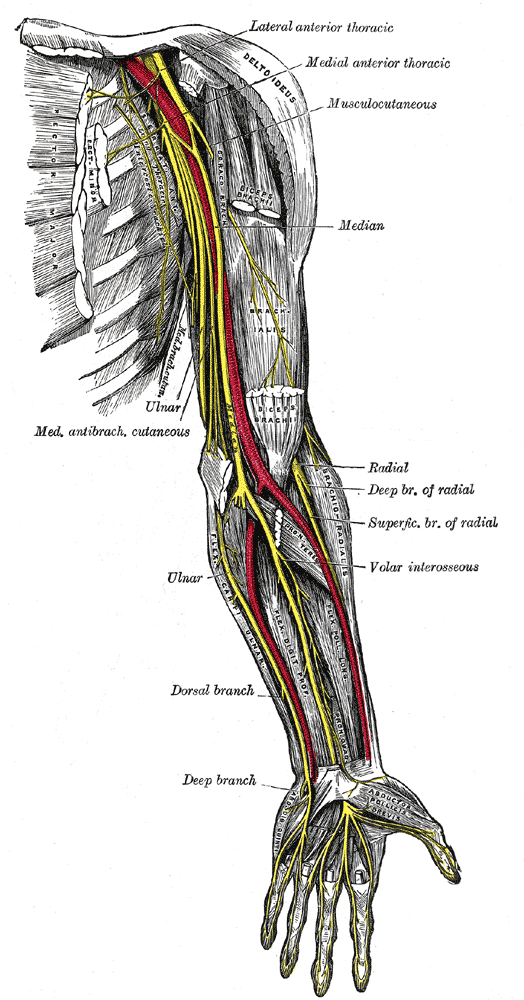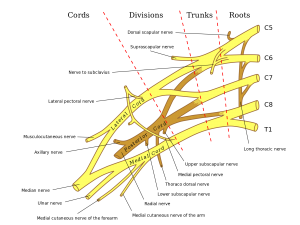Ulnar Nerve
Original Editor - Simisola Ajeyalemi
Top Contributors - Simisola Ajeyalemi, Kim Jackson, Fasuba Ayobami, Redisha Jakibanjar and Momina Khalid
Description[edit | edit source]
The ulnar nerve originates from C8-T1 nerve roots which form the medial cord of the brachial plexus. The ulnar nerve runs down the hand where it passes behind the medial epicondyle of the humerus at the elbow. The ulnar nerve doesn’t give branches in the axilla or in the upper arm. It starts giving muscular and cutaneous branches in the upper forearm and hand. After the ulnar nerve passes behind the medial epicondyle, it enters the forearm between the two heads of the flexor carpi ulnaris muscle. The ulnar nerve may become compressed or irritated as it passes behind the medial epicondyle. The ulnar nerve travels through the cubital tunnel that runs under the medial epicondyle. The nerve gives branches to the flexor carpi ulnaris and medial half of flexor digitorum profundus
 The ulnar nerve then travels alongside the ulnar bone of the forearm into the wrist. As the nerve descends into the forearm, it stays medially above the flexor digitorium profundus and under the flexor carpi ulnaris giving branches to these muscles. In the lower part of the forearm, the ulnar nerve lies lateral to the flexor carpi ulnaris muscle and medial to the ulnar artery. The ulnar nerve enters the palm of the hand through the Guyon canal. The nerve and artery pass superficial to the flexor retinaculum.
The ulnar nerve then travels alongside the ulnar bone of the forearm into the wrist. As the nerve descends into the forearm, it stays medially above the flexor digitorium profundus and under the flexor carpi ulnaris giving branches to these muscles. In the lower part of the forearm, the ulnar nerve lies lateral to the flexor carpi ulnaris muscle and medial to the ulnar artery. The ulnar nerve enters the palm of the hand through the Guyon canal. The nerve and artery pass superficial to the flexor retinaculum.
At the wrist, the ulnar nerve lies just lateral to the pisiform bone. The superficial branch of the ulnar nerve supplies and passes under the Palmaris brevis muscles and divides into palmar digital nerves. The deep branch of the ulnar nerve innervates the three hypothenar muscles, the two medial lumbricals, the seven interrosei, the adductor pollicis and the deep head of the flexor pollicis brevis. It supplies all intrinsic hand muscles which lie medial to the flexor pollicis except the last lateral two lumbricals.
Root[edit | edit source]
C8, T1
From the Medial cord of brachial plexus.
Branches[edit | edit source]
- Muscular branch
- Palmar cutaneous branch
- Dorsal cutaneous branch
Function[edit | edit source]
Motor[edit | edit source]
Anterior forearm
- Flexor carpi ulnaris
- Medial half of Flexor digitorium profundus
Hand
- Hypothenar muscles
- Medial two lumbricals
- Adductor pollicis
- Interossei of the hand
- Palmaris brevis
Sensory[edit | edit source]
Palmar cutaneous branch- innervates the skin of the medial half of the hand
Dorsal cutaneous branch- innervates the skin of the medial one and a half fingers, and the associated dorsal hand area.
Superficial branch- innervates the palmar surface of the medial one and a half fingers.
Clinical relevance[edit | edit source]
The ulnar nerve is most susceptible to injury at the elbow[1] and the wrist resulting in varying degrees of motor and sensory loss. Mechanism of injury includes local trauma, nerve impingement, lacerations at the wrist and Guyon canal cyst. Characteristic signs of injury to the ulnar nerve is the inability to grip paper between the fingers with long-term cases resulting in ulnar claw hand deformity.
There are two entrapment syndromes involving the ulnar nerve or its branches:
- Cubital Tunnel Syndrome
- Guyon canal syndrome
Assessment[edit | edit source]
Neuro exam[edit | edit source]
Weakness:
- Wrist flexion
- Flexion of the little finger
- Abduction of the index and little finger
- Adduction of the thumb
Diminished sensation:
- Palmar surface of the medial one and a half fingers
- Dorsal surface of the medial one and a half fingers
Neurodynamics[edit | edit source]
The upper limb neurodynamic test for the ulnar nerve(ULNT3) is performed with the patient in supine. The joints are moved sequentially and to the end of the range or until symptoms are produced. Patients are to be instructed to report the onset of any sensation such as stretch, tingling or pain anywhere in the arm or neck.
ULNT3 sequencing:
- Shoulder girdle depression
- Shoulder abduction
- Shoulder external rotation
- Wrist and Finger extension
- Elbow flexion
- Shoulder abduction
Treatment[edit | edit source]
Resources[edit | edit source]
See also[edit | edit source]
References[edit | edit source]
- ↑ Selby, Ronald; Safran, Marc; O'brien, Stephen (2007). "Practical Orthopaedic Sports Medicine & Arthroscopy, 1st edition: Elbow Injuries"
[[Category:Anatomy - Hand







